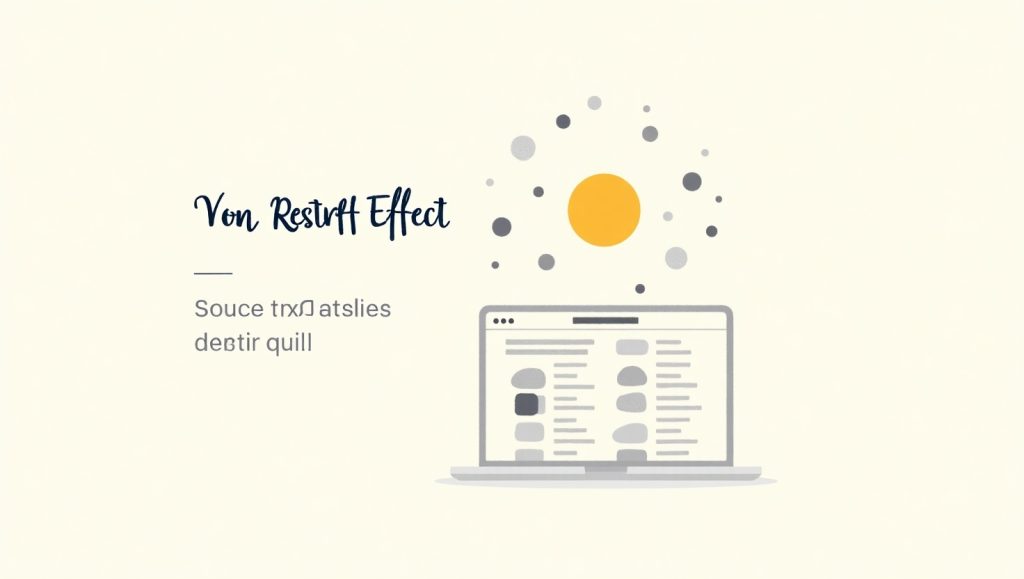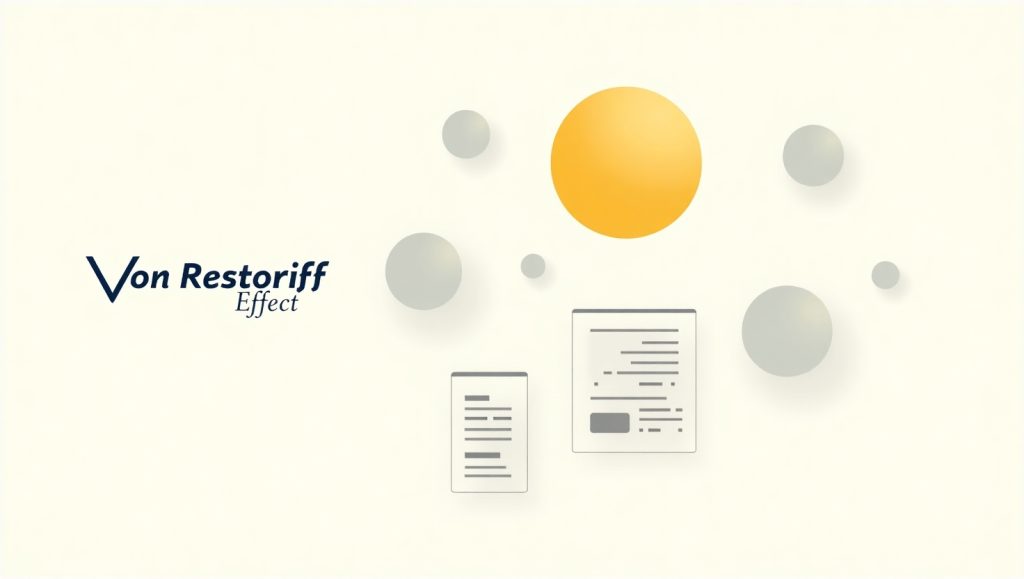
Distinctiveness is memory-JUXF-design-term. This theory is well understood with the help of the Von Restorff effect. Also called “isolation effect,” the Von Restorff Effect is an interesting psychological phenomenon that indeed influences our memory capacity: Given many similar items, the one which is different from all the others will be remembered better. The theory was first brought forth by German psychiatrist Hedwig von Restorff in 1933 and has since permeated into different domains of study, such as marketing, education, and most importantly, UX design.
Think of it this way: moving your cursor among black-and-white texts, and there appears one word brightly highlighted in neon yellow; that word instantly grabs your attention. It might sound simple, but in the rough environment of the digital world where users are shackled with umpteen information, to be different is to survive.
So how does the theory transfer over to a UX design? A well-timed application can mold user behavior, showcase crucial functionalities, and bring increased recall-and all of which are highly important in the overall success of a website or an application. Whether you are designing a call-to-action button or highlighting new features, there is no doubt that a solid understanding of how users perceive and remember elements on a page can allow you to create even more compelling digital experiences.
Why Understanding Human Psychology Helps Improve UX
The Role of Human Memory in User Experience
In the mind of a user, a lot more is going on during the interaction with a website or app, perhaps more than designers realize. They scan, filter, and decide within seconds. It is memory that helps users bind themselves with the content. If something doesn’t become an imprint on their memory, it is lost, and that is exactly what you don’t want in design.
By applying cognitive principles, including the Von Restorff Effect, designers can form perception to influence decisions. Say a user sees that particular button with a standout color or design; this is going to sink in good and deep and be acted upon by the user much later. This is essential to consider when designing the user onboarding flow, calls to action, or product showcases.
The design world really does not see memory as solely recall. Association is the way to go: The user might never remember the site’s name; however, if there was something visually unique about the layout or maybe even the CTA itself, it might just be enough to draw them back later.
Applying Emotional Triggers for Better Engagement
This concept rings especially true when we talk about designing orientated around human psychology. Since that is why the Von Restorff Effect comes into play, being that whatever stands out visually often will conjure an emotion- curiosity, urgency, excitement, and so on.
Suppose you have a banner showing limited-time offers in a bright red color. The red is a beacon, lighting up a feeling of urgency and thereby emotionally engaging a user. The operative phrase here is “getting more memorable” and “going into action.” Emotionally intelligent design yields clicks, conversions, and satisfaction.
How the Von Restorff Effect Is Used in UX Design

Highlighting Call-to-Actions Effectively
One of the common applications of the Von Restorff Effect in UX design is the creation of CTA buttons. If all elements in a website are in harmony, users tend to overlook the priority. Through color contrast, size variation, and unique shape options, special attention can be directed toward key actions such as “Sign Up”, “Buy Now”, or “Learn More”.
For example, in an otherwise minimalist landing page with lots of grey tones, the bold green CTA button clearly stands as the main focus. It disobeys the visual pattern and captures attention, thus increasing user interaction: undoubtedly good design-an excellent example of ingenious psychology.
This method, if used wisely, guarantees that the users do not get distracted. But the operative word here is “strategically.” If everything is unique, then nothing is. Use it sparsely to make only the most essential elements stand out.
Enhancing Product Feature Recognition
While introducing new features and/or tools, they somehow tend to go unnoticed by users, especially in interfaces that are already scattered with many other functionalities. Leveraging the Von Restorff Effect makes these new additions visually distinct. Think along the lines of a glowing badge beside a freshly launched feature or a tooltip with bright borders.
It grabs attention and also aids in user memory, thereby supporting quicker adoption of this new functionality; in other words, it boosts discoverability of your product while shaving off the learning curve for your users.
You can recognize this approach in Slack or Notion, where new features are often provided a special tag or label. These decisions on design are quintessentially very subtle yet impulsively impactful and are largely based on the Von Restorff Effect.
Best Practices for Using the Von Restorff Effect in UX
Use Contrast, But Don’t Overdo It
Contrast is the basis for the Von Restorff Effect. It can be anything—the color, the size, the shape, or maybe the typeface are all considered visual differences to guide the user’s eye. But if there are too many distractions, too much noise is created, hence adequate contrast will give way to confusion. So if everything on your page is bold or bright, it just loses all meaning.
So, concentrate on intentionality. A good question to ask is: What do I want the user to see first? Design for that consideration. Let’s say the ultimate goal is to prompt users to schedule a consultation: make that button the one element that truly stands out from the rest of the page.
Speaking of contrast, keep accessibility in mind. Use relevant tools to test color combinations and make sure they’re legible for everyone out there. Striking that good balance between standing out and being inclusive is a win-win for an effective and ethically designed site.
Make Important Elements Memorable, Not Just Noticeable
Noticeability is the first step, but it’s memorability that actually establishes long-term success. The Von Restorff Effect applies in instances where the element is not only visually distinct but also holds emotional or functional significance. Think about how Dropbox went with a hand-drawn illustration style while practically every other tech site was mocked up with clean vector art. That distinction stuck in people’s minds and became part of the brand identity.
When applying the effect in UX-focused website design strategies, focus on what matters most to your audience. What must they have memorized? Where do they mostly drop off? Once you have figured this out, use differentiation techniques to reel them back in.
Real-World Examples of the Von Restorff Effect in Action

E-commerce and Conversion Boosters
Here you apply this theory to a successful e-commerce website. Amazon, for example, promotes its “Today Deals” with bright orange tags that immediately attract attention, contrasting with the rest of the generally neutral-colored site. This method is not random; it is based on the Von Restorff Effect.
Used effectively, such distinctive tags stand out to call users’ attention to quickly expiring offers, limited inventories, or bundled discounts, creating urgency in increasing conversions through a simple way of finding what really engages the users. A/B testing involving variations of the so-called “standout” styles can disclose which of these styles converts better without altering the design as a whole.
Proper design like this is often addressed by professionals working at a high-ranking web design agency in Cardiff or somewhere else, where user engagement is a paramount consideration.
SaaS Platforms and User Onboarding
Many SaaS tools use the Von Restorff Effect during onboarding to give new users some basic familiarity with the key features. Think of a brightly colored tour bubble or pulsating icon that says “Click here to begin.” They are not mere decorative devices, but deliberately guided actions for the purpose of retention.
Adopting the protective modus operandi, the designers are purposely enabling one or two elements of the web by differentiating them through their appearance so the users are not burdened with choices. Therefore, they do not scan through a dozen links or buttons but just follow or click on one that is visually emphasized.
This type of design thinking is a key part of conversion-focused web design strategies aimed at improving user journeys from start to finish.
Conclusion
The Von Restorff Effect may seem like a glib explanation for something complicated; it makes UX seem all too simple yet very powerful. It is about setting at the right time things to stand out at the right moment in front of the user. Whether you are leading a user through a sign-up process, introducing a new feature to a product, or just trying to increase engagement, this principle can do wonders for you.
Keep in mind that to stand out does not mean to go over the top. It means being very intentional with choices in design that continue to tell users: notice this; remember this; act on this. If applied wisely, on the other hand, the Von Restorff Effect can take an average UX design to an eminently worthy one.
If one is working on a new digital project and wishes to retain that everlasting impression, one must consider the idea of how a professional web design expert could turn ordinary design elements into star performances.